Tire inflation TOYOTA CAMRY 2008 XV40 / 8.G Owners Manual
[x] Cancel search | Manufacturer: TOYOTA, Model Year: 2008, Model line: CAMRY, Model: TOYOTA CAMRY 2008 XV40 / 8.GPages: 476, PDF Size: 7.27 MB
Page 4 of 476

TABLE OF CONTENTSIndex
4
3-5. Using the storage features ........................... 267
List of storage features....... 267
• Glove box ......................... 268
• Console box ..................... 268
• Cup holders ...................... 270
• Auxiliary boxes ................. 272
3-6. Other interior features ..... 275 Sun visors .......................... 275
Vanity mirrors ..................... 276
Clock .................................. 277
Ashtrays ............................. 278
Power outlet ....................... 279
Seat heaters ....................... 281
Armrest............................... 283
Rear sunshade ................... 284
Trunk storage extension (vehicles with reclining
rear seat) .......................... 285
Floor mat ............................ 286
Trunk features .................... 287
Garage door opener ........... 288
Compass ............................ 293 4-1. Maintenance and care ...... 298
Cleaning and protecting the vehicle exterior ........... 298
Cleaning and protecting the vehicle interior ............ 300
4-2. Maintenance ...................... 303 Maintenance requirements .................... 303
General maintenance ......... 305
Emission inspection and maintenance (I/M)
programs .......................... 308
4-3. Do-it-yourself maintenance ................... 309
Do-it-yourself service precautions ....................... 309
Hood ................................... 313
Positioning the jack............. 314
Engine compartment .......... 316
Tires.................................... 334
Tire inflation pressure ......... 344
Wheels................................ 348
Air conditioning filter ........... 350
Key battery ......................... 353
Checking and replacing fuses ................................. 357
Light bulbs .......................... 368
4Maintenance and care
Page 7 of 476
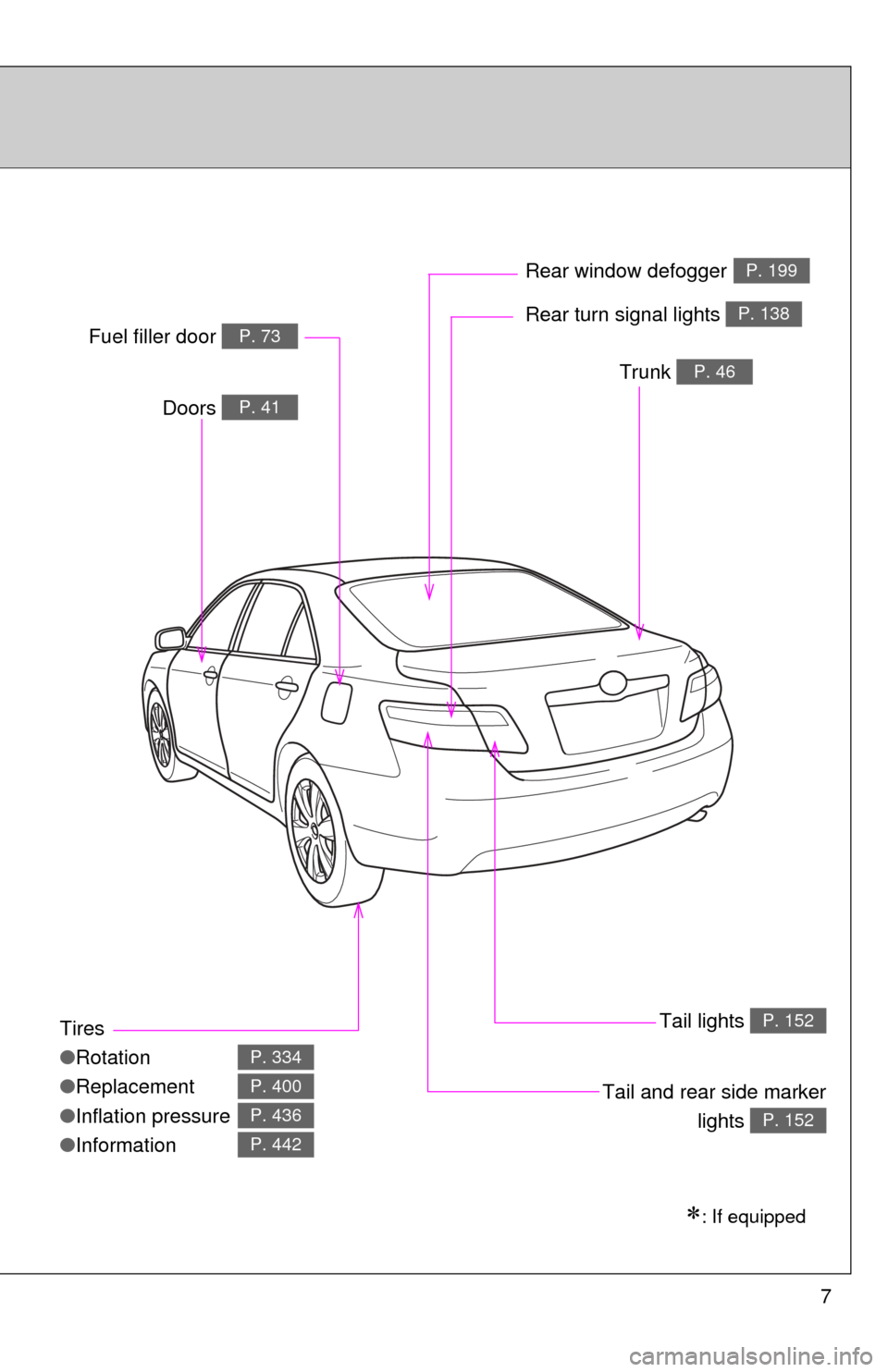
7
Tires
●Rotation
● Replacement
● Inflation pressure
● Information
P. 334
P. 400
P. 436
P. 442
Trunk P. 46
Doors P. 41
Fuel filler door P. 73Rear turn signal lights P. 138
Rear window defoggerP. 199
Tail lights P. 152
: If equipped
Tail and rear side marker
lights
P. 152
Page 297 of 476
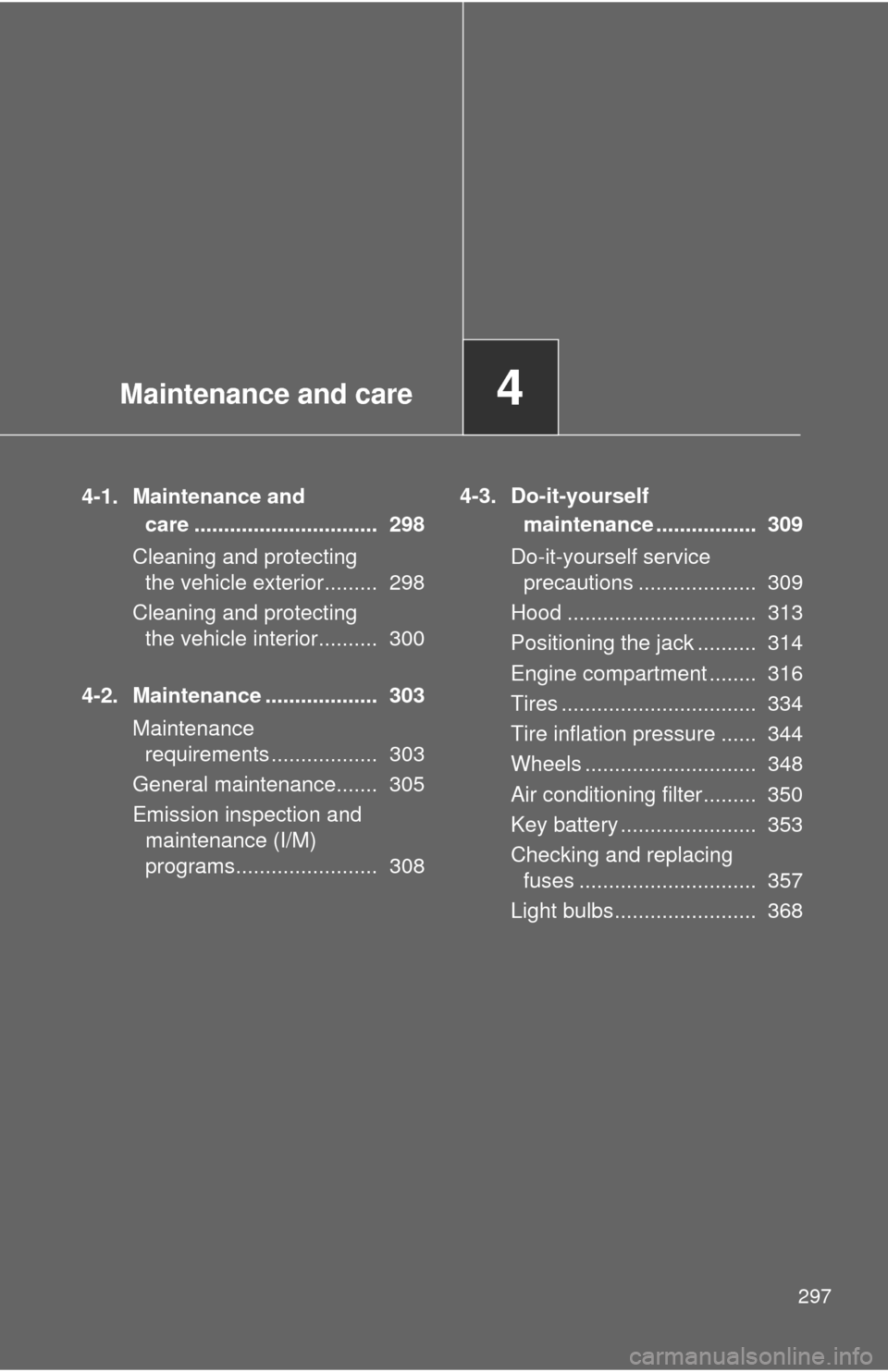
Maintenance and care4
297
4-1. Maintenance and care ............................... 298
Cleaning and protecting the vehicle exterior......... 298
Cleaning and protecting the vehicle interior.......... 300
4-2. Maintenance ................... 303 Maintenance requirements .................. 303
General maintenance....... 305
Emission inspection and maintenance (I/M)
programs........................ 308 4-3. Do-it-yourself
maintenance ................. 309
Do-it-yourself service precautions .................... 309
Hood ................................ 313
Positioning the jack .......... 314
Engine compartment ........ 316
Tires ................................. 334
Tire inflation pressure ...... 344
Wheels ............................. 348
Air conditioning filter......... 350
Key battery ....................... 353
Checking and replacing fuses .............................. 357
Light bulbs........................ 368
Page 307 of 476
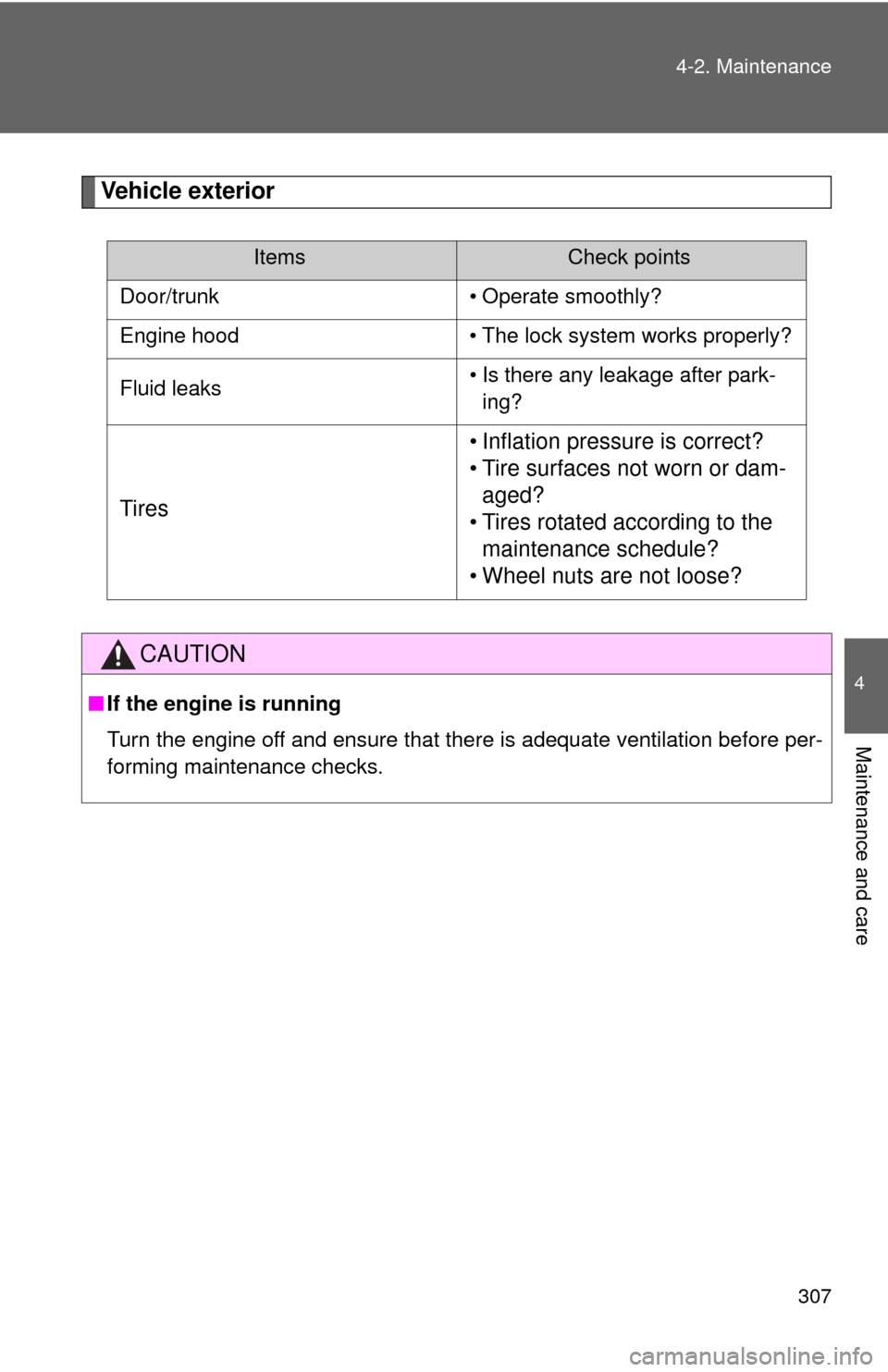
307
4-2. Maintenance
4
Maintenance and care
Vehicle exterior
ItemsCheck points
Door/trunk • Operate smoothly?
Engine hood • The lock system works properly?
Fluid leaks • Is there any leakage after park-
ing?
Tires • Inflation pressure is correct?
• Tire surfaces not worn or dam-
aged?
• Tires rotated according to the maintenance schedule?
• Wheel nuts are not loose?
CAUTION
■ If the engine is running
Turn the engine off and ensure that there is adequate ventilation before per-
forming maintenance checks.
Page 310 of 476
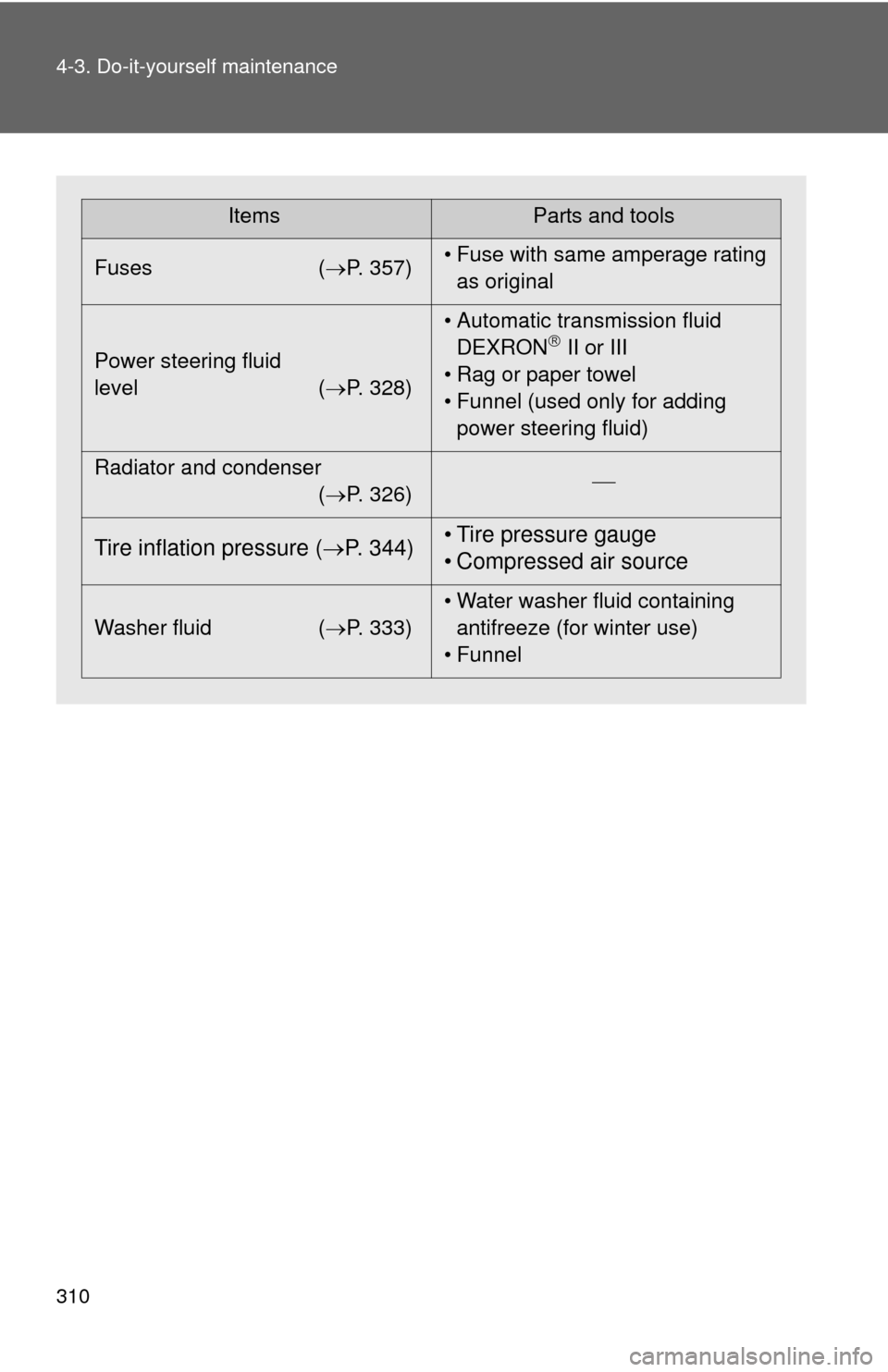
310 4-3. Do-it-yourself maintenance
ItemsParts and tools
Fuses ( P. 357)• Fuse with same amperage rating
as original
Power steering fluid
level ( P. 328)• Automatic transmission fluid
DEXRON
II or III
• Rag or paper towel
• Funnel (used only for adding power steering fluid)
Radiator and condenser (P. 326)
Tire inflation pressure (
P. 344) • Tire pressure gauge
• Compressed air source
Washer fluid
(P. 333) • Water washer fluid containing
antifreeze (for winter use)
• Funnel
Page 334 of 476
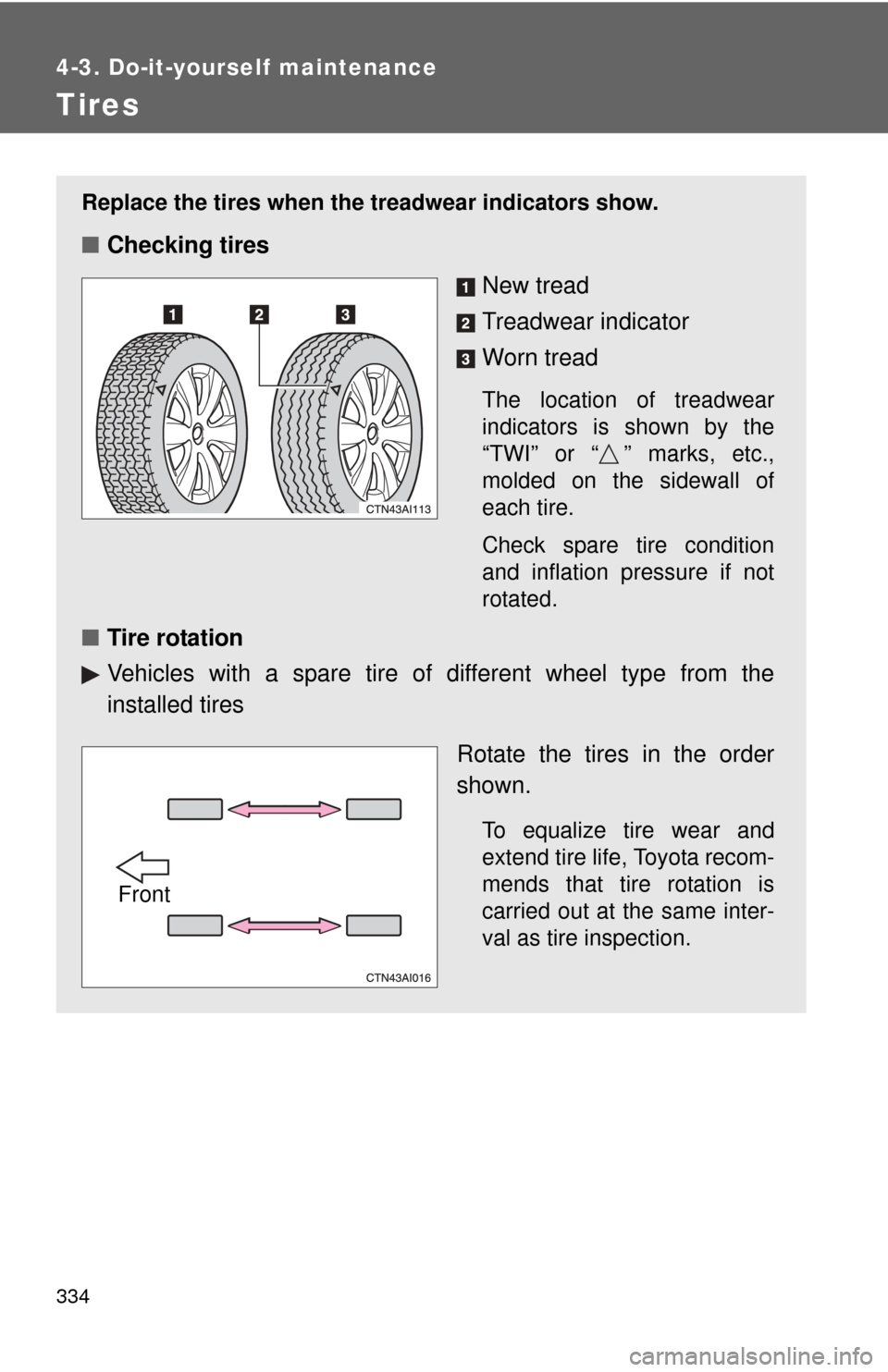
334
4-3. Do-it-yourself maintenance
Tires
Replace the tires when the treadwear indicators show.
■Checking tires
New tread
Treadwear indicator
Worn tread
The location of treadwear
indicators is shown by the
“TWI” or “ ” marks, etc.,
molded on the sidewall of
each tire.
Check spare tire condition
and inflation pressure if not
rotated.
■Tire rotation
Vehicles with a spare tire of different wheel type from the
installed tires
Rotate the tires in the order
shown.
To equalize tire wear and
extend tire life, Toyota recom-
mends that tire rotation is
carried out at the same inter-
val as tire inspection.
Front
Page 335 of 476
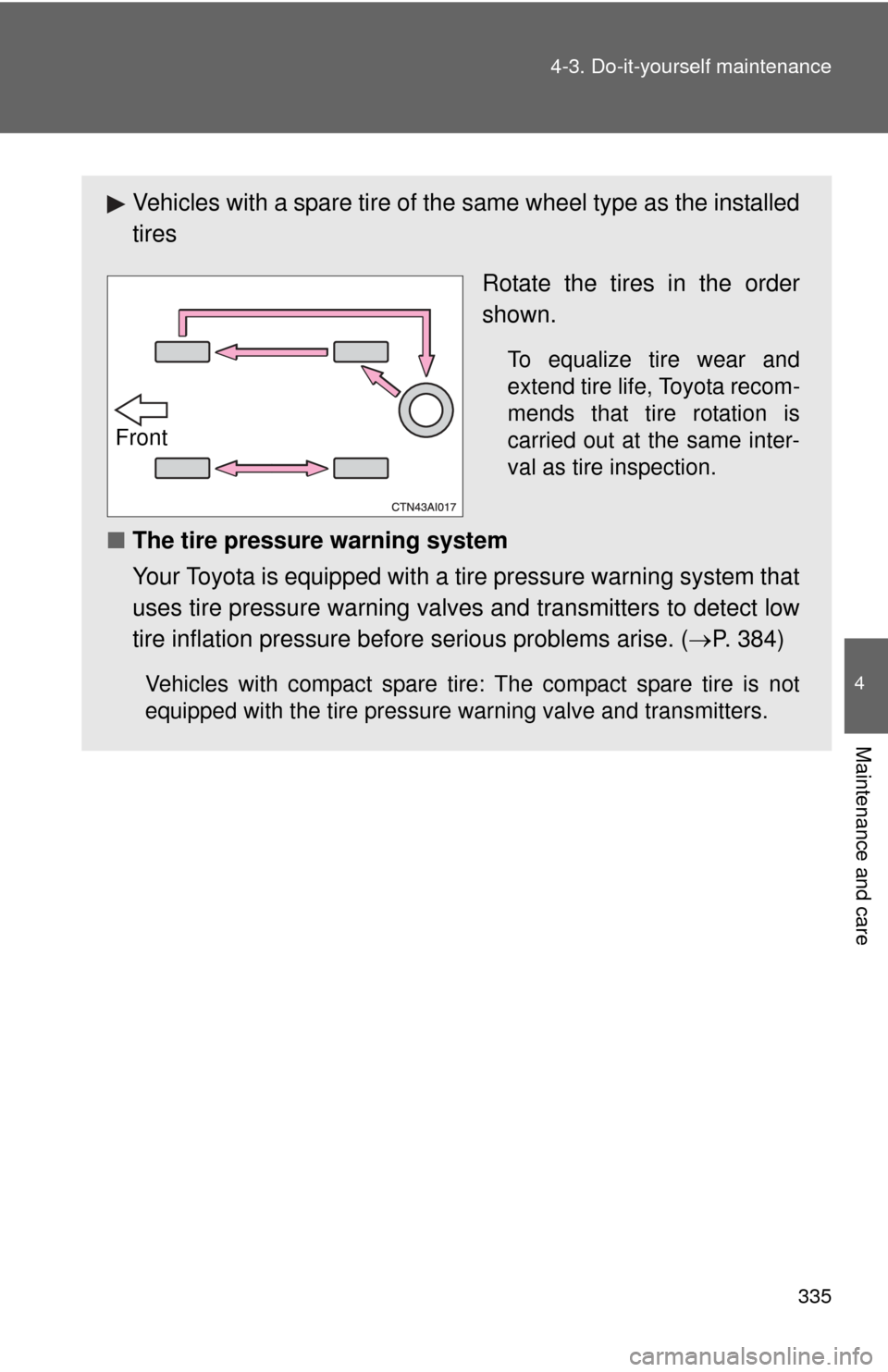
335
4-3. Do-it-yourself maintenance
4
Maintenance and care
Vehicles with a spare tire of the same wheel type as the installed
tires
Rotate the tires in the order
shown.
To equalize tire wear and
extend tire life, Toyota recom-
mends that tire rotation is
carried out at the same inter-
val as tire inspection.
■The tire pressure warning system
Your Toyota is equipped with a tire pressure warning system that
uses tire pressure warning valves and transmitters to detect low
tire inflation pressure before serious problems arise. (P. 384)
Vehicles with compact spare tire: The compact spare tire is not
equipped with the tire pressure warning valve and transmitters.
Front
Page 336 of 476

336 4-3. Do-it-yourself maintenance
Installing tire pressure warning valves and transmittersWhen replacing tires or wheels, tire pressure warning valves and
transmitters must also be installed.
When new tire pressure warning valves and transmitters are
installed, new tire pressure warn ing valve and transmitter ID codes
must be registered in the tire pressure warning computer and the tire
pressure warning system must be initialized. Have tire pressure
warning valve and transmitter ID codes registered by your Toyota
dealer. ( P. 337)
Initializing the tire pressure warning system
■ The tire pressure warning system must be initialized in the fol-
lowing circumstances:
● When changing the tire inflation pressure by changing traveling
speed or load weight, etc.
● When changing the tire size.
When the tire pressure warning syst em is initialized, the current tire
inflation pressure is set as the pressure benchmark.
■ How to initialize the tire pressure warning system
Park the vehicle in a safe place and turn the “ENGINE START
STOP” switch or the engine switch OFF.
While the vehicle is moving, in itialization is not performed.
Adjust the tire inflation pressure to the specified cold tire infla-
tion pressure level. ( P. 436)
Make sure to adjust the tire pressure to the specified cold tire
inflation pressure level. The ti re pressure warning system will
operate based on this pressure level.
Turn the “ENGINE START STOP” switch to IGNITION ON
mode (vehicles with smart key system) or engine switch to
“ON” position (vehicles without smart key system).
STEP1
STEP2
STEP3
Page 339 of 476

339
4-3. Do-it-yourself maintenance
4
Maintenance and care
■When the initialization of the tire pressure warning system has
failed
Initialization can be completed in a few minutes. However, in the follow-
ing cases, the settings has not bee
n recorded and the system will not
operate properly. If repeated attempts to record tire inflation pressure
settings are unsuccessful, have the vehicle inspected by your Toyota
dealer.
●When operating the tire pressure warning reset switch, the tire pres-
sure warning light does not flash 3 times.
●After driving for a certain period of time since the initialization has
been completed, the wa rning light comes on after blinking for 1
minute.
■Routine tire inflation pressure checks
The tire pressure warning system doe s not replace routine tire inflation
pressure checks. Make su re to check tire inflation pressure as part of
your routine of daily vehicle checks.
■Maximum load of tire
Check that the maximum load of the re placed tire is greater than 1/2 of
the Gross Axle Weight Ratings (GAWR) of either the front axle or the
rear axle, whichever is greater.
For the maximum load of the tire, see the load limit at maximum cold tire
inflation pressure mentioned on the sidewall of the tire, and for the Gross
Axle Weight Ratings (GAWR), s ee the Certification Label. (P. 344,
442).
Page 342 of 476

342 4-3. Do-it-yourself maintenance
CAUTION
■When inspecting or replacing tires
Observe the following precautions to prevent accidents.
Failure to do so may cause damage to parts of the drive train, as well as
dangerous handling characteristics, which may lead to fatal accidents or
injury.
●Do not mix tires of different makes, models, tread patterns or tread-
wear.
●Do not use tire sizes other than those recommended by Toyota.
●Do not mix radial, bias-belted, or bias-ply tires.
●Do not mix summer, all season and winter tires.
●Do not use tires that have been used on another vehicle.
Do not use tires if you do not know how they were used previously.
■When initializing the tire pressure warning system
Do not press the tire pressure warnin g reset switch without first adjusting
the tire inflation pressure to the spec ified level. Otherwise, the tire pres-
sure warning light may not come on ev en if the tire inflation pressure is
low, or it may come on when the tire inflation pressure is actually normal.